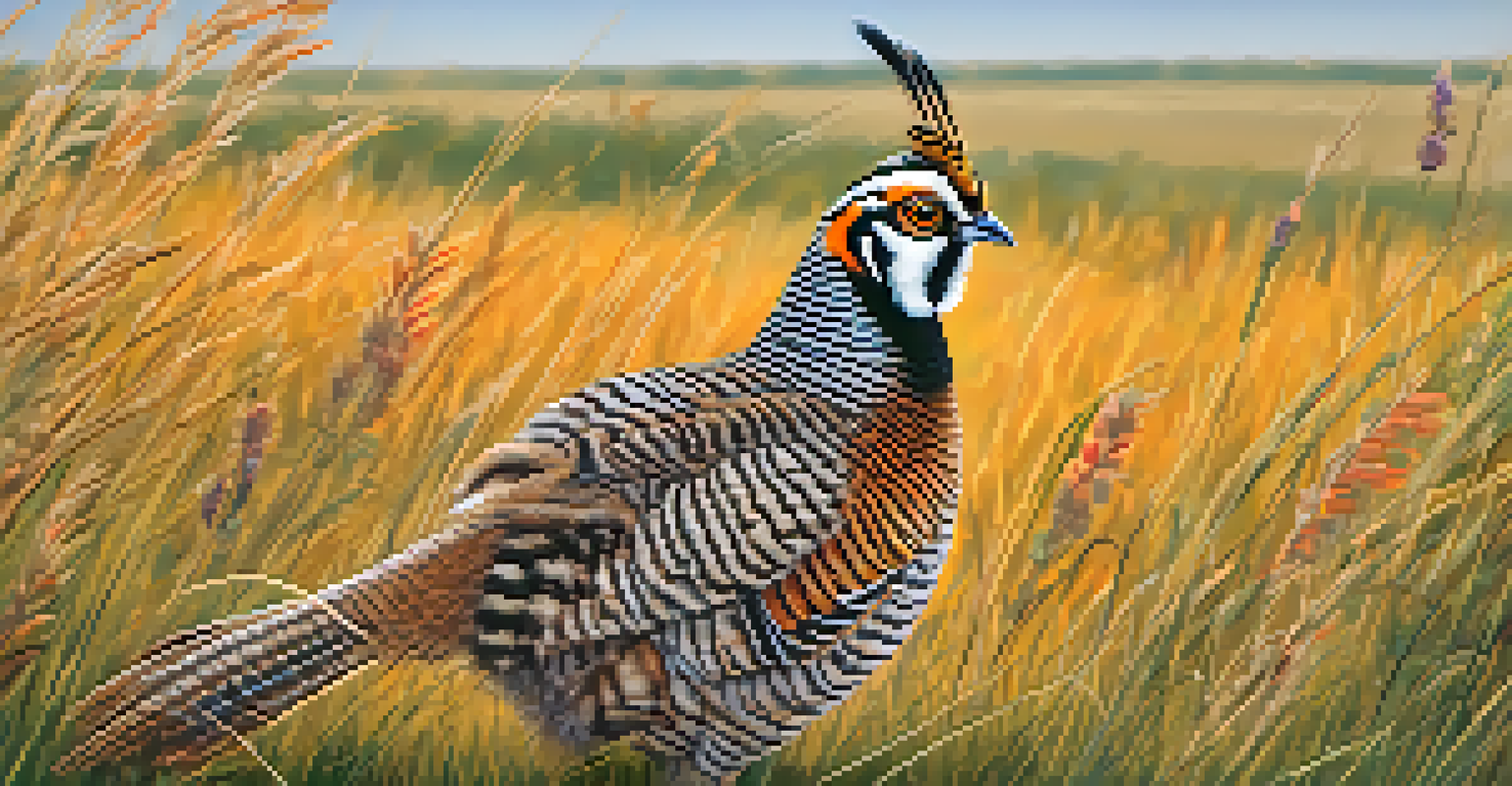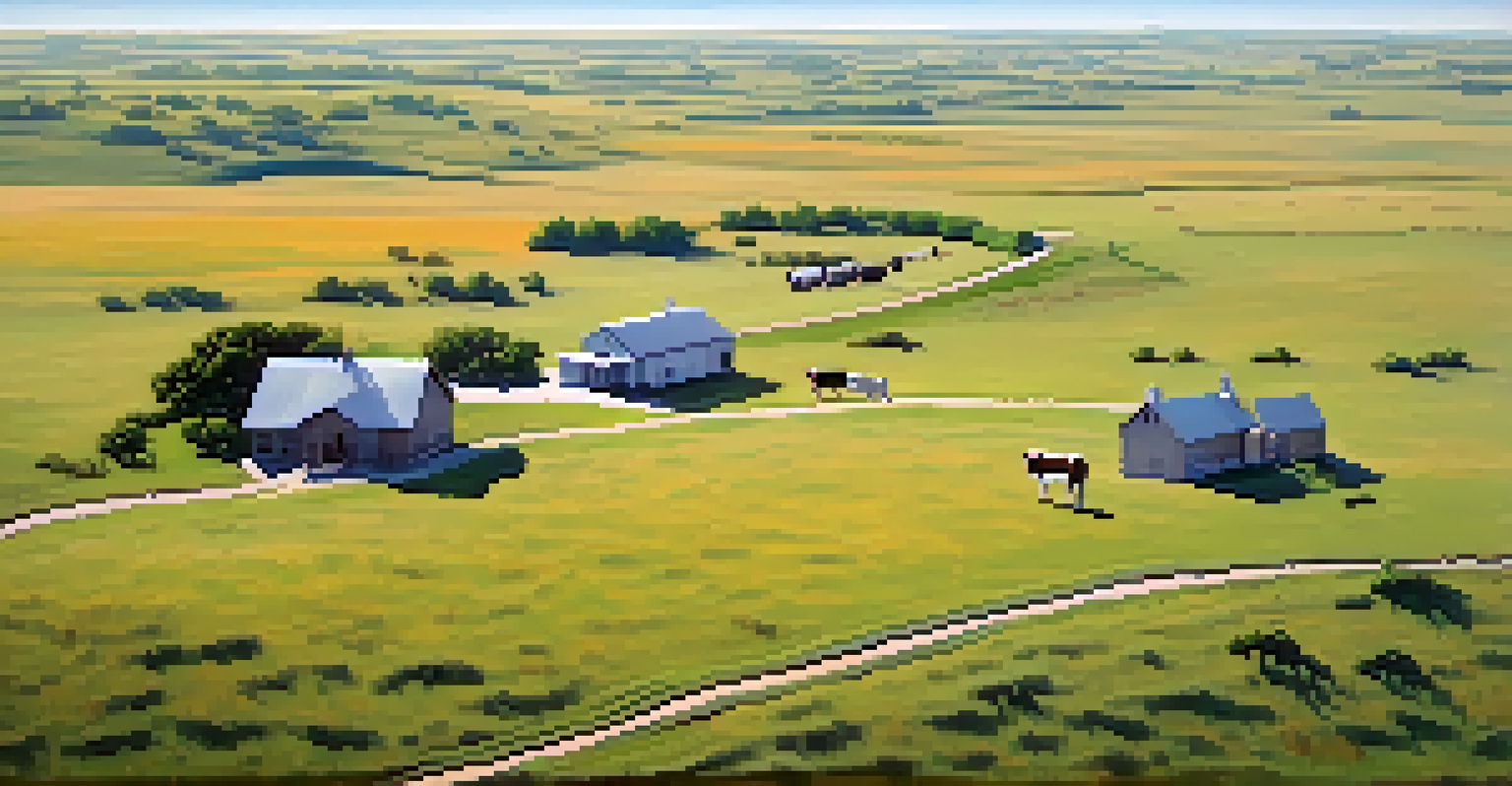The Flint Hills: Unique Geography and Ecological Importance

Introduction to the Flint Hills: A Geographic Overview
The Flint Hills, stretching across eastern Kansas and into Oklahoma, are a remarkable region characterized by their unique topography. Known for their tallgrass prairies, these hills are one of the last remaining expanses of this ecosystem in North America. The region's rolling hills, steep ravines, and limestone outcrops create a stunning landscape that's both beautiful and ecologically significant.
The Flint Hills are an example of how nature and culture can coexist and support one another.
This area’s geology is fascinating; it was shaped by ancient seas, glaciers, and the relentless forces of erosion. The Flint Hills get their name from the flint rock that is prevalent in the area, which historically made it difficult for farmers to plow the land. Instead of being turned into farmland, much of the land remains focused on cattle ranching and conservation, preserving its natural beauty.
Because of its geographic features, the Flint Hills support a diverse range of plant and animal life. This unique ecosystem, alongside its stunning vistas, draws visitors and researchers alike who are eager to learn more about the region's natural heritage.
Flint Hills: A Vital Tallgrass Prairie Ecosystem
The Flint Hills are home to one of the largest remaining tallgrass prairie ecosystems in the world, covering over 4 million acres. This biome is characterized by its rich biodiversity, which includes numerous species of grasses, wildflowers, and wildlife. The tallgrass prairie plays a crucial role in carbon sequestration, helping to mitigate climate change while providing habitats for various organisms.

Many species, such as the endangered Greater Prairie Chicken, rely on the tallgrass prairie for survival. These birds use the open spaces for their mating rituals and nesting. The health of this ecosystem is vital not just for these species but also for maintaining the ecological balance in the region.
Ecological Significance of Flint Hills
The Flint Hills host one of the largest remaining tallgrass prairie ecosystems, essential for biodiversity and carbon sequestration.
Moreover, the tallgrass prairie is essential for local ranching practices. The deep-rooted grasses are resilient and provide excellent forage for cattle, making ranching sustainable in this unique environment. This symbiotic relationship between the land and ranching practices helps preserve the prairie while supporting the local economy.
The Role of Fire in Maintaining the Flint Hills
Fire is a natural and essential part of the Flint Hills ecosystem. Historically, Native Americans used controlled burns to manage the land, promoting new growth and preventing tree encroachment. Today, prescribed burns are still used by ranchers and conservationists to maintain the health of the prairie and enhance its biodiversity.
To care for the land is to care for ourselves; the Flint Hills remind us of our connection to nature.
These controlled burns help to clear out dead grass and stimulate new growth, which is vital for both wildlife and livestock. The regeneration of grasses after a burn provides nutritious forage for grazing animals, ensuring that the land remains productive. Additionally, these fires help to suppress invasive species that threaten the delicate balance of this ecosystem.
While fire might seem destructive at first glance, it is a crucial tool for maintaining the ecological integrity of the Flint Hills. This natural process fosters a thriving environment where diverse species can flourish and adapt, showcasing the resilience of nature.
Flint Hills Wildlife: A Haven for Biodiversity
The Flint Hills are a sanctuary for a rich variety of wildlife, making it a prime location for nature enthusiasts and researchers. From small mammals to large grazing animals, the prairies are teeming with life. Species such as bison, deer, and countless bird species can be found roaming the hills, contributing to the area's ecological richness.
Birdwatchers flock to the Flint Hills during migration seasons, as the area serves as an important stopover for many migratory birds. The diverse habitats found within the region, from wetlands to open grasslands, support these birds and provide opportunities for observation and study. This makes the Flint Hills a critical area for bird conservation efforts.
Fire's Role in Ecosystem Health
Controlled burns are crucial for maintaining the health of the Flint Hills, promoting new growth and preserving the prairie’s ecological balance.
With its vast landscapes and diverse ecosystems, the Flint Hills are not just a beautiful setting; they are also a vital habitat for numerous species. Protecting this region ensures the survival of many wildlife populations and contributes to the overall health of the environment.
Human Impact: Ranching and Conservation Efforts
Human presence in the Flint Hills has significantly shaped its ecology and economy. Ranching is a cornerstone of the local culture, with generations of families managing the land and livestock sustainably. This longstanding tradition has fostered a deep connection between the people and the land, emphasizing the importance of responsible stewardship.
However, with the rise of urbanization and industrial agriculture, the Flint Hills face challenges that threaten its ecological integrity. Habitat loss and environmental degradation are pressing issues that require immediate attention. Fortunately, many local organizations and ranchers are actively engaged in conservation efforts to protect and restore the delicate balance of this unique ecosystem.
By promoting sustainable practices and raising awareness, these efforts aim to ensure that the Flint Hills continue to thrive for generations to come. The collaboration between ranchers, conservationists, and local communities is vital in preserving the ecological character of this region while supporting its cultural heritage.
Cultural Significance: The Flint Hills in History
The Flint Hills are steeped in history, with Native American tribes relying on its resources long before European settlers arrived. The tallgrass prairies provided food, shelter, and materials for these communities. Their deep understanding of the land and sustainable practices still resonate today in conservation efforts and land management strategies.
As settlers moved into the area, they brought with them agricultural practices that significantly altered the landscape. The challenges of farming on the rocky terrain led to a focus on ranching, which has become a significant part of the Flint Hills' identity. Today, this rich history is celebrated through various events and educational programs that highlight the region's heritage.
Cultural Heritage and Ranching
The Flint Hills are deeply rooted in history, with ranching practices that reflect a sustainable connection between the land and local communities.
Preserving the cultural significance of the Flint Hills is essential for future generations. By understanding the past, we can better appreciate the importance of sustainable practices and the need to protect this unique landscape and its history.
Visiting the Flint Hills: An Ecotourism Destination
For those looking to experience the natural beauty and ecological significance of the Flint Hills, ecotourism offers a wonderful opportunity. Visitors can explore the stunning landscapes through hiking, birdwatching, and photography. Many local farms and ranches provide tours, allowing guests to learn about sustainable ranching practices and the importance of conservation.
The Flint Hills also host several events throughout the year, including festivals that celebrate the region's culture and ecology. These gatherings bring together locals and visitors, fostering a sense of community and appreciation for the land. Engaging with the local culture adds depth to the experience and supports the economy.

By visiting the Flint Hills, individuals not only enjoy the breathtaking scenery but also contribute to the preservation of this unique ecosystem. Responsible tourism helps raise awareness about the ecological importance of the region, ensuring that it remains protected for future generations to explore and cherish.